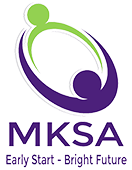Both are important! Learning to speak clearly involves coordinating the brain and muscle in very complex ways. It requires a great deal of practice. The more you and your child communicate in ways that let him take the lead and talk frequently, the more likely he is to speak more like you.
FAQ Category: SPEECH AND LANGUAGE
Should I demand that my child speaks “adult perfect” speech?
No. Your child learns to speak clearly in small steps. Encourage him to change by coming a little closer to you. Be very careful not to make him feel failure if he does not say the word just like you do. Come to appreciate small changes in your child’s speech; when you show you do, he will regards you with even more changes.
What should I do if I do not understand my child’s speech?
Model language by talking in short sentences that your child can imitate. Your child needs practice hearing speech in pieces he can do. Your child’s language can be hard to understand. Replying with expressions such as “really” or “show me” will encourage more language. Take notice of where your child is looking. Most of the time he is talking about something within his/her view.
Are there any techniques that therapists use that I can try at home to help my children develop their language skills?
Try expanding what your child says (adding 1-2 words to what he said), providing a good verbal model for the child to follow, commenting on the actions of yourself and your child, having the child imitate words after you, providing associations/additional vocabulary words to the child’s words, and repeating the same new words in front of your child in many different situations.
What types of activities can I do to stimulate my child’s language development?
Talk to your child about everything! Talk about things you are doing: washing dishes (plates, bowls, silverware), setting the table (forks on napkin, spoon next to knife), bath time (reinforce naming body parts), dressing the child (body parts and spatial relationships, i.e. leg in pants), laundry (name socks, shirts, pants). Provide new experiences for your child by taking him to new places: supermarket (name fruits and vegetables); playgrounds (talk as you push your child on a swing); television (talk about shows with your child, like Sesame Street); airport (see planes arrive and depart); zoo (animals, what they eat).
My child is age 3 ½ and lately has been stuttering a lot. I keep telling her to “slow down and think”. What else can I do?
Between ages 2½-5, when children are learning how to speak, 25% of children will display dysfluencies. It is best addressed by not bringing any attention or saying anything about the dysfluencies present. If your child develops what we call “secondary characteristics” such as eye-blinking, foot stamping or facial grimaces or if the stuttering gets worse, the dysfluencies should be addressed by a speech therapist.
My child just turned 2, seems to understand everything said to him, and is only saying a few words. Should I be concerned?
Normal speech and language development can proceed at very different rates. It is common for most 2 year-olds to have a 40-50 word vocabulary and to be just starting to put 2 words together. Others may be able to carry on a conversation. An evaluation would be recommended for 2 year-old children in the following situations: no spoken words or fewer than 40 words, not imitating words, or difficulty understanding language. An audiological evaluation is also recommended to rule out a hearing component present.
My child is 2 ½ years old and can’t say the “s” and the “th” sounds. Should I be concerned?
Not yet. A child at age 2 ½ is only expected to be approximately 65-70% intelligible when speaking. The “s” and “th” sounds are later developing sounds.
